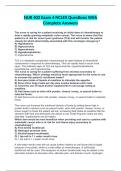Exam (elaborations)
NUR 402 Exam 4 NCLEX Questions With Complete Answers
- Course
- Institution
NUR 402 Exam 4 NCLEX Questions With Complete Answers The nurse is caring for a patient receiving an initial dose of chemotherapy to treat a rapidly growing metastatic colon cancer. The nurse is aware that this patient is at risk for tumor lysis syndrome (TLS) and will monitor the patient close...
[Show more]



